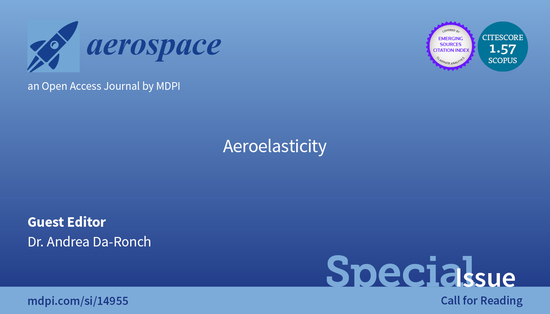Special Issue: Aeroelasticity
Acknowledgments
Conflicts of Interest
References
- Quero, D.; Vuillemin, P.; Poussot-Vassal, C. A Generalized State-Space Aeroservoelastic Model Based on Tangential Interpolation. Aerospace 2019, 6, 9. [Google Scholar] [CrossRef]
- Boutet, J.; Dimitriadis, G. Unsteady Lifting Line Theory Using the Wagner Function for the Aerodynamic and Aeroelastic Modeling of 3D Wings. Aerospace 2018, 5, 92. [Google Scholar] [CrossRef]
- Eaton, A.J.; Howcroft, C.; Coetzee, E.B.; Neild, S.A.; Lowenberg, M.H.; Cooper, J.E. Numerical Continuation of Limit Cycle Oscillations and Bifurcations in High-Aspect-Ratio Wings. Aerospace 2018, 5, 78. [Google Scholar] [CrossRef]
- Vio, G.A.; Munk, D.J.; Verstraete, D. Transient Temperature Effects on the Aerothermoelastic Response of a Simple Wing. Aerospace 2018, 5, 71. [Google Scholar] [CrossRef]
- Muc, A. Natural Frequencies of Rectangular Laminated Plates—Introduction to Optimal Design in Aeroelastic Problems. Aerospace 2018, 5, 95. [Google Scholar] [CrossRef]
- Rozov, V.; Volmering, A.; Hermanutz, A.; Hornung, M.; Breitsamter, C. CFD-Based Aeroelastic Sensitivity Study of a Low-Speed Flutter Demonstrator. Aerospace 2019, 6, 30. [Google Scholar] [CrossRef]
- Pusch, M.; Ossmann, D.; Luspay, T. Structured Control Design for a Highly Flexible Flutter Demonstrator. Aerospace 2019, 6, 27. [Google Scholar] [CrossRef]
- Grauer, J.A.; Boucher, M.J. Identification of Aeroelastic Models for the X-56A Longitudinal Dynamics Using Multisine Inputs and Output Error in the Frequency Domain. Aerospace 2019, 6, 24. [Google Scholar] [CrossRef]
- Sun, Y.; Wang, Y.; Da Ronch, A.; Meng, D. A Fast Correction Method of Model Deformation Effects in Wind Tunnel Tests. Aerospace 2018, 5, 125. [Google Scholar] [CrossRef]
- Fichera, S.; Isnardi, I.; Mottershead, J.E. High-Bandwidth Morphing Actuator for Aeroelastic Model Control. Aerospace 2019, 6, 13. [Google Scholar] [CrossRef]
- Wang, Y.; Da Ronch, A.; Ghandchi Tehrani, M. Adaptive Feedforward Control for Gust-Induced Aeroelastic Vibrations. Aerospace 2018, 5, 86. [Google Scholar] [CrossRef]
- Cheng, Y.; Li, D.; Xiang, J.; Da Ronch, A. Energy Harvesting Performance of Plate Wing from Discrete Gust Excitation. Aerospace 2019, 6, 37. [Google Scholar] [CrossRef]
© 2019 by the author. Licensee MDPI, Basel, Switzerland. This article is an open access article distributed under the terms and conditions of the Creative Commons Attribution (CC BY) license (http://creativecommons.org/licenses/by/4.0/).
Share and Cite
Da Ronch, A. Special Issue: Aeroelasticity. Aerospace 2019, 6, 92. https://doi.org/10.3390/aerospace6090092
Da Ronch A. Special Issue: Aeroelasticity. Aerospace. 2019; 6(9):92. https://doi.org/10.3390/aerospace6090092
Chicago/Turabian StyleDa Ronch, Andrea. 2019. "Special Issue: Aeroelasticity" Aerospace 6, no. 9: 92. https://doi.org/10.3390/aerospace6090092





